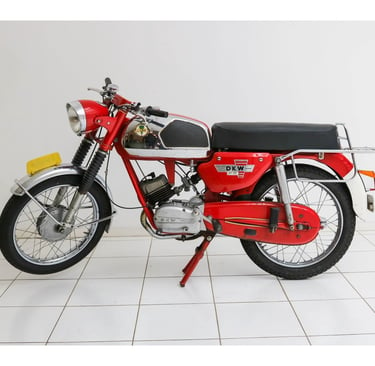Nostalgic Ride: The Comprehensive Chronicle of the DKW RT 139 Moped
The DKW RT 139 Moped is a significant vehicle that represents the post-war era of practical and affordable transportation. It was a collaboration between DKW and Zweirad-Union, featuring a 50cc two-stroke engine and innovative engineering solutions. The moped had various names and was the precursor to a line of utilitarian mopeds. The article also discusses the evolution of its engines, production timeline, and its enduring cultural and technological heritage.
GERMANY TWO STROKEVINTAGE MOPEDSDKW1940'S
12/18/20233 min read


Nostalgic Ride: The Comprehensive Chronicle of the DKW RT 139 Moped
Introduction
The DKW RT 139 Moped stands as a testament to the confluence of engineering ingenuity and economic necessity. Born in an era where mobility assumed newfound significance in the post-war landscape, the RT 139 is a snapshot of motor history—encapsulating the evolution of a two-wheeled companion that catered to the masses' craving for autonomy. It promises an exhilarating dive into the past—an echelon of classic motoring where the vintage never fades and is always celebrated.
Historical Journey
The historical narrative surrounding the DKW RT 139 is inextricably linked to the post-war context of ingenuity and frugality. This two-wheeled marvel emerged during the restoration of a shaken European landscape, embodying the spirit of an era that demanded practicality and affordability in personal transport. The collaboration of pioneering designers at DKW and Zweirad-Union led to the fabricating of a moped that was both accessible and efficient. The RT 139, with its distinctive aesthetics and mechanical prowess, was a mode of liberation for a society on the cusp of an economic renaissance.
Technical Insights
Beneath the elegant veneer of the DKW RT 139 lay a tapestry of technical sophistication. Its heart, a robust 50cc two-stroke engine, pulsated with a modest 3 horsepower, a testament to the minimalist engineering philosophy of the time. The powertrain was a marvel—equipped with a Bing 1/14/103 carburetor and a transmission featuring a 'drawing wedge circuit' that innovatively managed power delivery through its four gears. Its signature feature, a 5-Disk-Lamellas clutch, underscored a commitment to reliability. In an era where mechanical simplicity equated to longevity, the DKW RT 139 stood out with its ingenious engineering solutions—from thermal value spark plugs to its unique suspension system.
Identity Crisis
The DKW RT 139 was known by many names, a reflection of its distributed production and marketing through various affiliates such as Zweirad Union, Victoria, and Express. This multiplicity of identities was a common marketing practice for mopeds in the period, aimed at tapping into diverse regional consumer bases. The RT 139, Zweirad Union 139, Express 139, and Victoria 139, while in essence the same mechanical creation, represent the scope of branding efforts that helped enshrine the vehicle in the hearts and garages of riders across Europe.
Model Variations and Legacy
The RT 139 was not an isolated specimen but rather the progenitor of an entire lineage of utilitarian mopeds. The Mockick model of the 1970s stands as a notable descendant, drawing heavily from the RT 139's design ethos while infusing modernized touches. As the DKW brand evolved, so did the mopeds under its banner, with the DKW RT 125 of 1968 acting as a bridge between generations, carrying forward the RT 139's legacy of efficiency and functionality. These successive iterations not only demonstrated DKW's commitment to continuous improvement but also secured the RT 139's place in the annals of moped history.
Engines and Components
The powerplant of the DKW RT 139 tells its own tale of evolution and adaptation. Initially, the moped was powered by an engine designed by DKW's engineers, a conception born directly from the zeitgeist of motor innovation of the time. Later on, the deployment of Sachs engines heralded a period of transition, merging legacy design with the prowess of Sachs's engineering expertise. This blend of Old World craftsmanship with new-age components not only imbued the moped with greater diversity but also stirred discussions about the essence of its engineering lineage.
Production Timeline
Determining the exact moment when the first DKW RT 139 rolled off the assembly line has been mired with ambiguity. However, the evidence leans towards a production start in the early 1960s, with sources suggesting a genesis as early as 1962. The history of the RT 139's production is a chronicle of variance, with details often obscured by the fog of passing decades. Yet, even through the haze of history, the RT 139 stands as a resilient symbol of postwar mobility—its timeline a testament to the enduring appeal of its design and engineering.
Conclusion
As our exploration of the DKW RT 139 Moped concludes, we are left with a profound respect for its impact on the moped landscape. This modest yet mighty conveyance has traversed the temporal roads from its heyday to modern times, cementing its status as more than just a mode of transportation, but rather as an artifact of cultural and technological heritage. For enthusiasts and historians alike, the RT 139's story is a captivating tale of mobility, ingenuity, and the perennial human desire to journey with freedom and flair.
